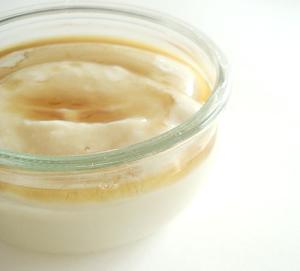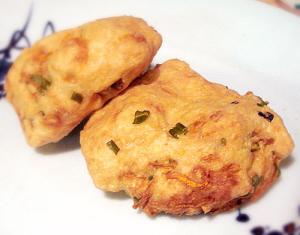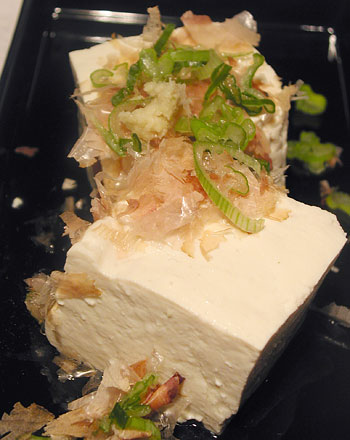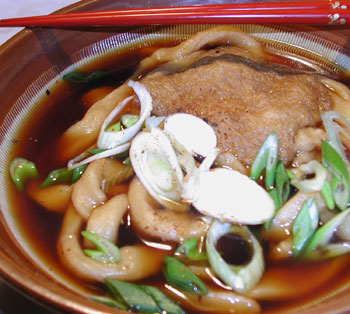
One of the things I like to do with tofu that didn't quite come together is to turn it into a pudding. Now I do not pretend to you that this tastes like a proper pudding or mousse made with cream and such, and if anyone tries to convince you that a tofu based dish like this is 'just as good/rich as the real thing' they are either lying or have no taste buds. It's different, but still good. It's a lightly sweet, cool and creamy dish that will quiet a sudden urge for Something Sweet. Since it's quite healthy it will leave you feeling righteous, thus the name.
It's also a dish that you can whip up in no time at all. I realize that many of the recipes here take a lot of time, effort or both, and I'm going to try to rectify that. Look for recipes with the quickcook or under 10 tags.
Filed under:
dessert lighter vegetarian sweet tofu quickcook vegan under10
Recently reader Joanna emailed asking why her home made tofu was, while creamy, not turning into an actual block of tofu. This happens to me sometimes too. The non-coagulated creamy tofu (which looks rather like fresh ricotta) can still be used in ganmodoki and other recipes that call for mashed up tofu, so it doesn't have to go to waste. Still, it is disappointing when, after all the trouble you've gone to to make tofu, your carefully formed block disintegrates instead of holding firm.
Filed under:
japanese tofu

Ganmodoki or hiryouzu are small deep-fried fritters made of tofu and various ingredients. They are either eaten as-is or cooked in a broth. They are used as a meat substitute in sho-jin ryouri, vegan buddhist cuisine. (They are supposed to taste like deer meat, though they don't at all.)
Ganmodoki is sold pre-made in supermarkets, in the refrigerated section, and is usually eaten in an oden, a sort of stew of various fishcakes and such. But store bought ganmodoki, which has the texture of a sponge, is nothing like freshly made ganmodoki. Once you have tried a freshly made, piping hot ganmodoki, it's just about impossible to think about saving them for later.
I have tried baking these or pan-frying them instead of deep frying, but the texture just isn't the same. It just demands that crispy-crunchy delicate crust given by the oil. If it's any consolation, they don't really absorb much oil.
Yamaimo
One ingredient that gets omitted in a lot of English-language ganmodoki recipes is yamaimo, often called Japanese Yam. It is a root vegetable that is tremendously viscous in texture, sort of like the inside of an okra. It gives a sort of bouncy yet light texture to whatever it's added to. You can find fresh yamaimo in the produce section of Japanese grocery stores, cut into sections and wrapped in plastic. It's quite expensive but you usually only need a little bit of it, and keeps quite well in the refrigerator well as long as you re-wrap it in plastic to prevent the ends from oxidizing. The cut ends were traditionally dipped in some fine sawdust for storage. You may also be able to find yamaimo powder (Note to European readers - Japan Centre in the UK carries this). Regular grated potato can be used as a substitute if you can't find yamaimo - it gives a different texture but still adds that sort of bouncy quality. It has to be grated to a fine pulp, not into shreds.
The other ingredients
All the additions to ganmodoki are there to add texture, umami, or both. You can vary it quite a bit by adding things that capture your imagination. You can even turn it into a more Western-flavored item by adding things like green peas, finely chopped and cooked mushrooms, and so on, and eating them with a bit of Worcestershire sauce or even ketchup. However, to my mind the traditional Japanese flavor is the best.
Filed under:
japanese vegetarian tofu vegan

What's the best way to eat really fresh tofu? My favorite every time is hiyayakko (cold tofu), but agedashi-dofu (deep fried tofu with dashi sauce) is a close second.
Filed under:
japanese legumes tofu
In Part 1, I showed you how to make your own pure, unadulterated soy milk. Now let's turn this into tofu(豆腐). Tofu is soy milk that has been coagulated with the addition of a harmless chemical. (Incidentally the kanji characters for tofu literally mean fermented beans, but tofu is not fermented in any way - at least as it's made currently.)
Filed under:
basics japanese weekend project legumes tofu
Sometimes I wonder if cooking is an art or science. I guess it's a bit of both. Some types of cooking though are almost pure science. Bread baking for example, especially when dealing with natural leavening or sourdough breads. Making a pie crust or a delicate cake is rather scientific too.
Filed under:
japanese legumes vegetarian tofu

I haven't participated in Is My Blog Burning, the original food blogging event initiated by Alberto, for quite a while. However, I couldn't pass up on this month's theme, hosted by Cooking With Amy: noodles. I love noodles in all shapes and from all corners of the world.
Filed under:
japanese tofu noodles

Note: This article has been substantially improved and updated here, but I'm leaving this original as-is for the simpler approach using canned skins.
[Another update: Lower-calorie inarizushi filled with a mixture of rice and hijiki seaweed
Filed under:
japanese rice sushi tofu